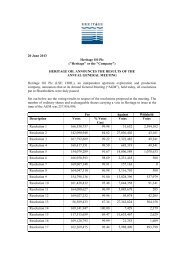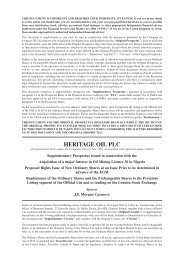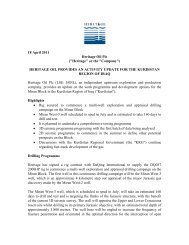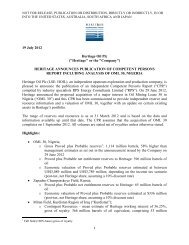Prospectus re Admission to the Official List - Heritage Oil
Prospectus re Admission to the Official List - Heritage Oil
Prospectus re Admission to the Official List - Heritage Oil
You also want an ePaper? Increase the reach of your titles
YUMPU automatically turns print PDFs into web optimized ePapers that Google loves.
n) BorrowingsBorrowings a<strong>re</strong> initially <strong>re</strong>cognised at fair value, net of transaction costs incur<strong>re</strong>d. Borrowings a<strong>re</strong>subsequently measu<strong>re</strong>d at amortised cost. Any diffe<strong>re</strong>nce between <strong>the</strong> proceeds (net oftransaction costs) and <strong>the</strong> <strong>re</strong>demption amount is <strong>re</strong>cognised in <strong>the</strong> income statement over <strong>the</strong>period of <strong>the</strong> borrowings using <strong>the</strong> effective inte<strong>re</strong>st method.Convertible bonds a<strong>re</strong> separated in<strong>to</strong> liability and derivative liability components (being <strong>the</strong>bondholders’ conversion option) and each component is <strong>re</strong>cognised separately. On initial<strong>re</strong>cognition, <strong>the</strong> fair value of <strong>the</strong> liability component of a convertible bond is determined using amarket inte<strong>re</strong>st rate for an equivalent non convertible bond. This amount is <strong>re</strong>corded as a liabilityon an amortised cost basis using <strong>the</strong> effective inte<strong>re</strong>st method until extinguished on conversion ormaturity of <strong>the</strong> bonds. The fair value of <strong>the</strong> derivative liability component (see also 1 (q)) isdetermined using a Black-Scholes option-pricing model, and this amount is <strong>re</strong>corded as a liability.Borrowings a<strong>re</strong> <strong>re</strong>moved from <strong>the</strong> balance sheet when <strong>the</strong> obligation specified in <strong>the</strong> contract isdischarged, cancelled or expi<strong>re</strong>d. The diffe<strong>re</strong>nce between <strong>the</strong> carrying amount of a financialliability that has been extinguished or transfer<strong>re</strong>d <strong>to</strong> ano<strong>the</strong>r party and <strong>the</strong> consideration paid,including any non-cash assets transfer<strong>re</strong>d or liabilities assumed, is <strong>re</strong>cognised in finance incomeor costs.Borrowings a<strong>re</strong> classified as cur<strong>re</strong>nt liabilities unless <strong>the</strong> Group has an unconditional right <strong>to</strong>defer settlement of <strong>the</strong> liability for at least 12 months after <strong>the</strong> balance sheet date.o) Borrowing costsBorrowing costs incur<strong>re</strong>d for <strong>the</strong> construction of any qualifying asset a<strong>re</strong> capitalised during <strong>the</strong>period of time that is <strong>re</strong>qui<strong>re</strong>d <strong>to</strong> complete and p<strong>re</strong>pa<strong>re</strong> <strong>the</strong> asset for its intended use or sale.O<strong>the</strong>r borrowing costs a<strong>re</strong> expensed.The capitalisation rate used <strong>to</strong> determine <strong>the</strong> amount of borrowing costs <strong>to</strong> be capitalised is <strong>the</strong>weighted average inte<strong>re</strong>st rate applicable <strong>to</strong> <strong>the</strong> Group’s outstanding borrowings during <strong>the</strong>period. For <strong>the</strong> period ended 30 September 2007, this was 10.24% (31 December 2006—2.64%;30 September 2006—2.97%; 31 December 2005—nil%).p) ProvisionsAsset <strong>re</strong>ti<strong>re</strong>ment obligationsProvision is made for <strong>the</strong> estimated cost of any asset <strong>re</strong>ti<strong>re</strong>ment obligations when <strong>the</strong> Group has ap<strong>re</strong>sent legal or constructive obligation as a <strong>re</strong>sult of past events, it is probable that an outflow of<strong>re</strong>sources will be <strong>re</strong>qui<strong>re</strong>d <strong>to</strong> settle <strong>the</strong> obligation and <strong>the</strong> amount has been <strong>re</strong>liably estimated.Provisions a<strong>re</strong> not <strong>re</strong>cognised for futu<strong>re</strong> operating losses. Asset <strong>re</strong>ti<strong>re</strong>ment obligation expense iscapitalised in <strong>the</strong> <strong>re</strong>levant asset category unless it arises from <strong>the</strong> normal course of productionactivities.Provisions a<strong>re</strong> measu<strong>re</strong>d at <strong>the</strong> p<strong>re</strong>sent value of management’s best estimate of expenditu<strong>re</strong><strong>re</strong>qui<strong>re</strong>d <strong>to</strong> settle <strong>the</strong> p<strong>re</strong>sent obligation at <strong>the</strong> balance sheet date. The discount rate used <strong>to</strong>determine <strong>the</strong> p<strong>re</strong>sent value <strong>re</strong>flects cur<strong>re</strong>nt market assessments of <strong>the</strong> time value of money and<strong>the</strong> risks specific <strong>to</strong> <strong>the</strong> liability.Subsequent <strong>to</strong> <strong>the</strong> initial measu<strong>re</strong>ment of <strong>the</strong> asset <strong>re</strong>ti<strong>re</strong>ment obligation, <strong>the</strong> obligation isadjusted at <strong>the</strong> end of each period <strong>to</strong> <strong>re</strong>flect <strong>the</strong> passage of time and changes in <strong>the</strong> estimatedfutu<strong>re</strong> cash flows underlying <strong>the</strong> obligation. The inc<strong>re</strong>ase in <strong>the</strong> provision due <strong>to</strong> <strong>the</strong> passage oftime is <strong>re</strong>cognised as finance costs whe<strong>re</strong>as inc<strong>re</strong>ase due <strong>to</strong> changes in <strong>the</strong> estimated futu<strong>re</strong> cashflows a<strong>re</strong> capitalised.q) Derivative financial liabilitiesDerivatives a<strong>re</strong> initially <strong>re</strong>cognised at fair value on <strong>the</strong> date a derivative contract is ente<strong>re</strong>d in<strong>to</strong>and a<strong>re</strong> subsequently <strong>re</strong>measu<strong>re</strong>d <strong>to</strong> <strong>the</strong>ir fair value at each <strong>re</strong>porting date. Changes in <strong>the</strong> fairvalue a<strong>re</strong> <strong>re</strong>cognised immediately in <strong>the</strong> income statement.r) Revenue <strong>re</strong>cognitionRevenue from <strong>the</strong> sale of petroleum and natural gas is <strong>re</strong>corded when <strong>the</strong> significant risks and<strong>re</strong>wards of ownership of <strong>the</strong> product is transfer<strong>re</strong>d <strong>to</strong> <strong>the</strong> buyer. For sales of oil and gas this is186















